Al-Furqān’s E-Database
Al-Furqān’s role in raising awareness and supporting research to explore the Islamic written heritage is unsurpassed in modern times.
In response to digital advancements, Al-Furqān established an online E-Database back in 2013, when it celebrated its 25th Anniversary under the motto “25 Years Serving the Islamic Written Heritage”.
‘Al-Furqān’s E-Database presents a wealth of content from unique references and primary sources. This content, once only available in printed format, is now fully digitised and accessible in a user-friendly and interactive manner. This digitisation work is part of the Foundation's continuous mission in enabling research within the field of Islamic written heritage. The Foundation is fulfilling this mission by making this wealth of knowledge easily retrievable and freely accessible to the researchers across the world.
This online platform is available in both Arabic and the English language.
Our E-Database contains five main databanks:
- ‘World Collections’: bibliographic information about manuscripts and manuscript collections worldwide.
- ‘Manuscripts’: a continuously growing repository of works in the field of Islamic written heritage.
- ‘Maqasid’: a comprehensive bibliography within the field of the objectives of Islamic law.
- ‘Our Library’: the online catalogue of the references and specialised collections that can be consulted in house.
- ‘Our Publications’: an overview about the Foundation’s publications.
The size of each databank / collection is displayed - in numbers - under the respective name on the navigation bar; and these numbers are updated regularly and whenever new items are added to the particular databank / collection.
This online platform is equipped with four basic navigation areas, which can be found consistently in every databank / collection page, i.e.:
a) ‘Basic Search’ area: a general search window, equipped with helpful filters, in order to limit the search, while carrying a general search. The user can search for an item by: Title, Subject, Author and Library, as well as by choosing a certain databank / collection within the digital repository.
b) ’Databanks / Collections’ navigation bar: this allows the users to search within each databank / collection.
c) ‘Refine’ tab: to help narrow down the search, using various parameters, such as type, language and size of a certain collection. These parameters differ in each databank / collection, reflecting the respective content.
d) ‘Browse by’ tab: to help users explore further content on a particular databank / collection, through certain parameters, such as place, date, name, topic, etc. These parameters differ in each databank / collection, reflecting the respective content.
e) ‘Results’ page: by default, this page lists results in alphabetical order.
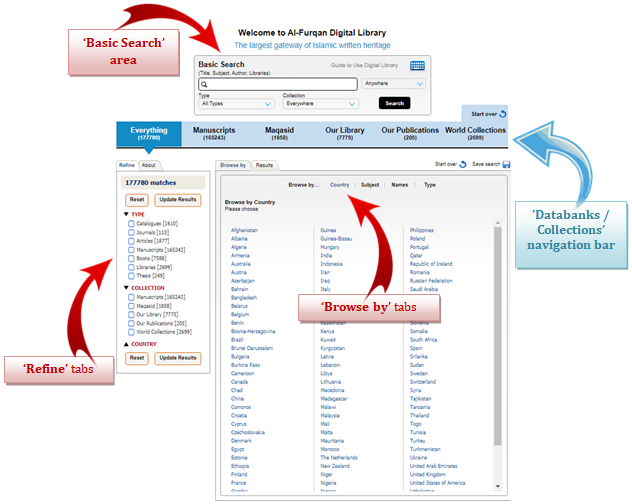
The E-Database is designed in a way that enables the users to navigate through the information intuitively and by cross-searching between the abovementioned databanks / collections, which are interlinked through the various access points of ’Date’, ’Place’, ‘Name’ and ‘Topic’.
Therefore, while users can search each databank / collection separately within its own page, they can also review the results of all collections grouped in one place, i.e. in the “Everything” page. This page provides a quick overview of the results in all five databanks / collections. By using the ‘Refine’ filters, users are able to navigate and narrow or widen the results by selecting from a number of options related to the type of resources, the collection, and the country. Also, they can ’Browse’ the digital content in the same page by exploring the ’Subject’ and ’Names’ of contributors (such as authors and compilers).
The results listed on the “Everything” page further indicate the collection it is held in.
Users can abandon the search performed at any stage, as they can clear all selections made in the different filters of each page simultaneously, by clicking on the ’Start over’ button.
Users can also create their own account in our E-Database, where all actions performed can be saved for future reference, such as conducted searches, search results, or items marked as favourite.
Furthermore, account holders can choose to be updated with future events organised by the Foundation, such as public events and courses, as well as receive notifications about the latest publications and offers.
A detailed ‘Guide to Use E-Database’ can be found at the top of the online E-Database page.
Exploring the databanks / collections included in the Al-Furqān E-Database
1. ‘World Collections’ databank / collection
The ‘World Collections’ databank / collection holds the digitised outcome of the survey on the collections of Islamic manuscripts in the world, completed and published by the Al-Furqān Foundation in 1994, under the title “The World Survey of Islamic Manuscripts”.. This Survey is available in both the English and Arabic language.
This flagship project (the only one of this type to date) started in 1989, focusing on identifying and recording undocumented Islamic manuscript collections in the world, with the aim to support and instigate research into the field of Islamic manuscripts. A number of known scholars and experts contributed to this encyclopaedic work.
The Survey identified collections in 106 countries. It is a compilation of detailed independent studies, highlighting just over a million and a half Islamic manuscripts from just over 2,500 collections. These collections, in more than 40 languages, belong to public and private libraries in almost 1,300 cities. It gathered extensive information about these libraries, including details about their establishment and the status of their collections, unveiling in the process rare manuscripts. For example, the collection of manuscripts at the Institute of Oriental Culture (University of Tokyo) - that was acquired in 1987 - included several new and unique Islamic manuscripts. The noteworthy discoveries were two copies of Risala fi anwaʿ al-mashruʿat, a comprehensive work on the terminology of jurisprudence, by Luṭf Allah al-Kaydani (died 1349 AD /750 AH). These were significant findings, as they had not even been mentioned in the most renowned classical period references, such as Brockelmann's famous work Geschichte der Arabischen Litteratur (GAL), Sezgin's Geschichte Des Arabischens Schriftums (GAS), and Kaḥḥala's Muʿjam al-muʾallifin.
A large number of the identified libraries have listed and included detailed descriptions about the manuscripts held in their collection, in a form of a document or publication. This publication is known as a ‘catalogue’; with most of them published and available for purchase. Another form of a published catalogue is one that was compiled by a group of libraries, known as ‘library consortium’. These libraries partnered to combine their collections into one unified published catalogue, known as a ‘union catalogue’.
Some libraries held collections that were not catalogued or documented. Others made an attempt to describe their collections in simplified lists and general documentations. These were usually not published and are known as ‘unpublished catalogues’.
A unique outcome of the Survey was the identification of all the various catalogues. Just over 5,500 catalogues of Islamic manuscripts were surveyed, including the listing of almost 700 union catalogues, and almost 1,000 unpublished catalogues.
All this information and much more is ready to be explored on the Al-Furqān's E-Database, under the ‘World Collections’ databank.
The following navigational tools are available to help discover the collections, and spark off research:
a) ‘Refine’ tab: the user can restrict the search by limiting it to five parameters: ‘Type of institution’, ‘Size of collection’, ‘Date of establishment’, ‘Language’ and ‘Subject’. Regarding the parameter of ‘Subject’, it is worth mentioning that it is unavailable on the published version of the survey. Due to this, we prioritised the inclusion of ‘Subjects’ as part of the ‘World Collection’.
b) ‘World Map’: a display area of the world map, to help represent visually the geographical location of the libraries surveyed. These locations are highlighted on the map. The user is able to zoom in the map, in order to inspect the region and the spread of the libraries in any particular area.
c) ‘Browse by’ tab: to help users choose from a number of options to narrow down their search. Users can explore the libraries by ‘Country’, ‘City’ or ‘Library’.
d) ‘Results’ page: by default, this page lists all the libraries identified in the survey alphabetically. It also displays the search results in the same order. To help study the results more easily, the list displays the Library name, the City and Country it is located in, the ‘Type’ of the library (institutional or private), and the total number of Catalogues held.
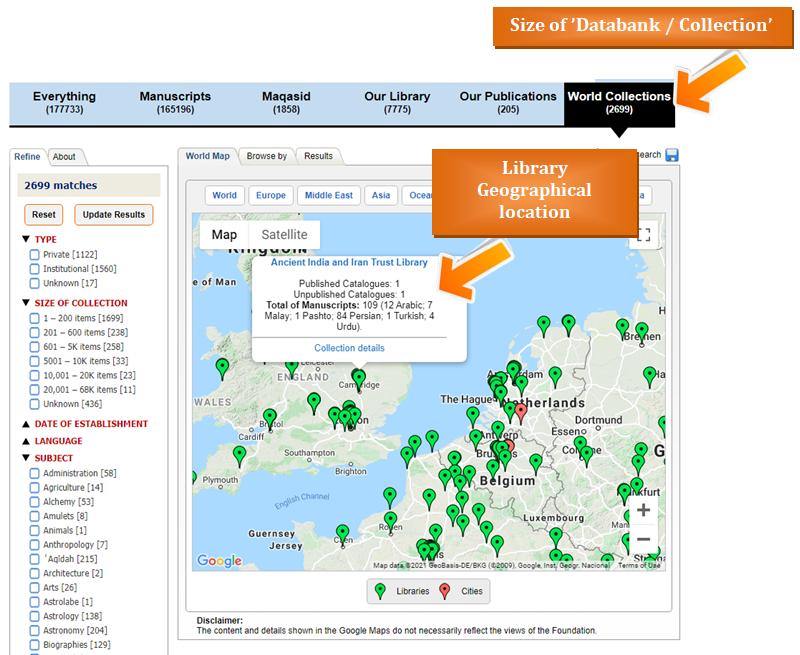
Once the users specify the Library they wish to explore, they will be taken to the final destination, where details about that particular Library are revealed in three sections:
The first section contains:
a) ‘Library Description’ page: this includes the contact details (postal address and telephone number), date of establishment, the status of the library (private or public), the size of the collection (total number of Islamic manuscripts), a summary description of the collection, and the total number of published and unpublished catalogues. A link to the library is also available.
b) ‘Library Catalogue Collection’ page: this page provides the listing of the catalogue collections of the library, both published and unpublished. Many of these resources are available in the Foundation's Library (under Special Collections), which can be consulted in house. Information about how to access the physical copy of the item listed, can be accessed by following the link to ‘Our Library’.
c) ‘Info & Ref’ page: this page provides the listing of the union catalogues of the collection, and the bibliographies used to support the information provided about the library explored. Many of these resources are also available in the Foundation's Library (under Special Collections), and can be accessed by following the link to ‘Our Library’.
The second section contains the option to go back to the main page of that particular collection, where the following options are provided:
a) ‘Your Feedback about this Library’: the user can use this tool to leave their impression about the library searched. The aim is to allow for an open platform for researchers to express their user experience when physically or virtually using the library.
b) ‘Purchase World Survey’: the user is offered the option to acquire a copy of the printed World Survey of Islamic Manuscripts. The user can also find out more details about the published Survey, including the full content listing of each of the four volumes. This information is available for both editions, Arabic and English, respectively.
The third section contains a ‘Did you know’, where the user can find the full listing of all types of catalogues and their counts regarding the country to which the viewed library belongs. The user is also able to go through the suggested libraries and interchangeably view them on the ‘World Map’ page.
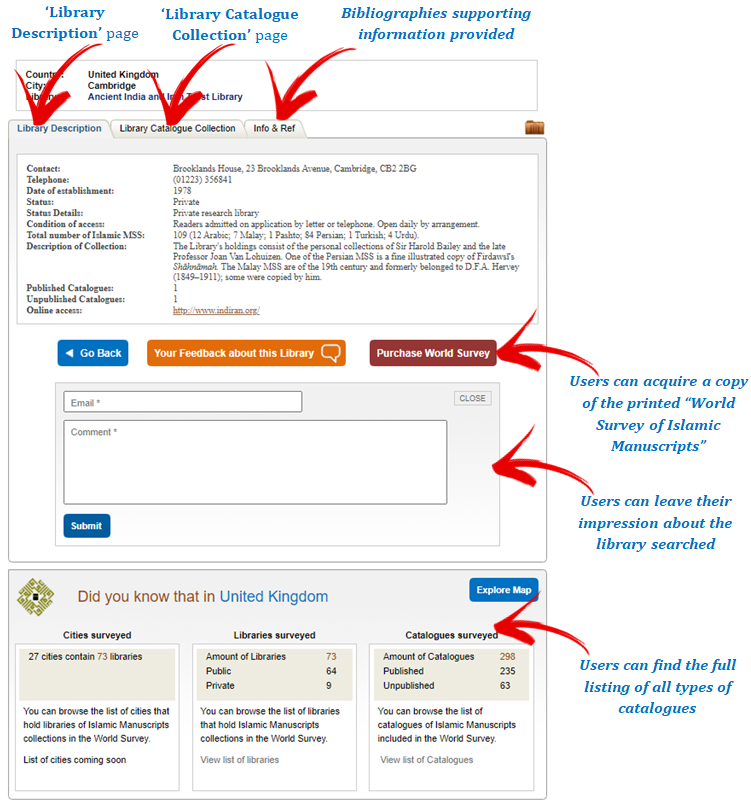
The Foundation is resolute in its continuous efforts in raising awareness about the Islamic manuscripts libraries and collections scattered around the world. Therefore, the Foundation aims to enrich the ‘World Collections’ databank by updating, and identifying new libraries and collections of Islamic manuscripts.
For users who wish to delve deeper into their research and consult the content of the catalogues, they can visit the second databank / collection, under the name ‘Manuscripts’, which houses the digital content of many of these catalogues.
2. ‘Manuscripts’ databank / collection
The ‘Manuscripts’ databank / collection presents a large amount of bibliographical records of Islamic manuscripts.
The Foundation concentrated its efforts - at first - in digitising the manuscript collections that were catalogued and published by itself (over 83,000 records, from just over 80 libraries, in 18 countries)
After completing the digitisation of these collections, the Foundation established cooperation bridges with different institutions and libraries around the world, which resulted in hosting their respective manuscript collection bibliographic data within the Foundation’s E-Database. All this, with the aim of creating an ultimate gateway to the Islamic written heritage, making it easier for scholars and researchers in this field to reach the required bibliographic data in real time and by ‘one click’.
The Al-Furqān E-Database currently holds around 165,000 manuscript records; and, it is a continuously and rapidly growing platform.
The following navigational tools are available within the ‘Manuscript’ databank / collection, in order to help discover the collections and delve into the multitude of their content:
a) ‘Refine’ tab: the user can filter the search by using five parameters, namely: the ‘Autograph’ copies, ‘Type’, ‘Language’, ‘Script’, ‘Specialised’ information (‘Waqf’, ‘Sama’s’, ‘Ijaza’ and ‘Tamaluk’) and by ‘Decoration’ (Illumination, Maps, Images & Drawings’ and ‘Illustrations’). The total count of each option in this area is provided between square brackets. These adjust automatically when the user selects a collection from the ‘Browse by’. This option provides the user with a preview of the characteristics of the collection browsed.
b) ‘Browse by’ tab: helps the user to explore the worldwide collection of manuscripts, through browsing the ‘Library’ of certain collections by ‘Name’ of author or the copyist, the ‘Topic’ covered by the manuscripts, and by when the manuscript was written, i.e. ‘Date Compiled’.
c) ‘Results’ page: by default, this page lists all the manuscripts located within a selected library / collection, organised by titles in alphabetic order. To help study the results more easily, the list displays the ‘Title (s)’ of manuscripts within that particular collection, the ‘Author(s)’, the ‘Date Compiled’, the ‘Library’ where this manuscript is housed, and the key information of the ‘Classmark', which is the identification of the physical copy.
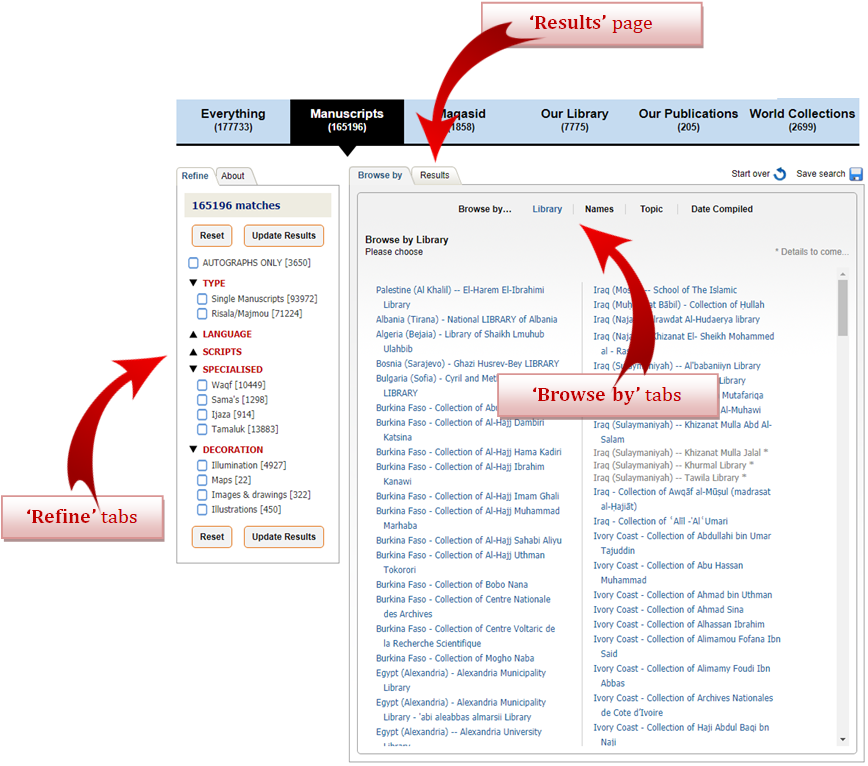
The user can review the manuscript’s details by selecting a title from the results table. Once the selection is made, the user is transferred to the ‘Manuscript Details’ page.
This page provides information (when available) in the following layout:
a) ‘Manuscript Details’ page: this page provides the cataloguing details of the manuscript/s explored. This includes bibliographical and physical description (page numbers, size of the written surface, number of lines in a page etc.). This page also provides the beginning (Incipit) and ending text (Explicit) of the manuscript/s. Extensive notes about the manuscript and its condition is also available. More specialised information is also included when available, such as details about ‘Waqf’, ‘Sama’s’, ‘Ijaza’ and ‘Tamalluk’.
b) ‘Read Catalogue Introduction’ page: when the introduction of the catalogue which contains the original details of the manuscript is available, it is included in this page. This provides further context support to the researcher, in case he/she wants to know more information about the published copy of the catalogue.
c) ‘Library Details’ page: when the information about the library holding a particular collection is available, this page displays details about that library. This page also interlinks with the ‘World Collections’ databank. It directs the user interchangeably to the ‘Library Details’ page, for more information about the library holdings.
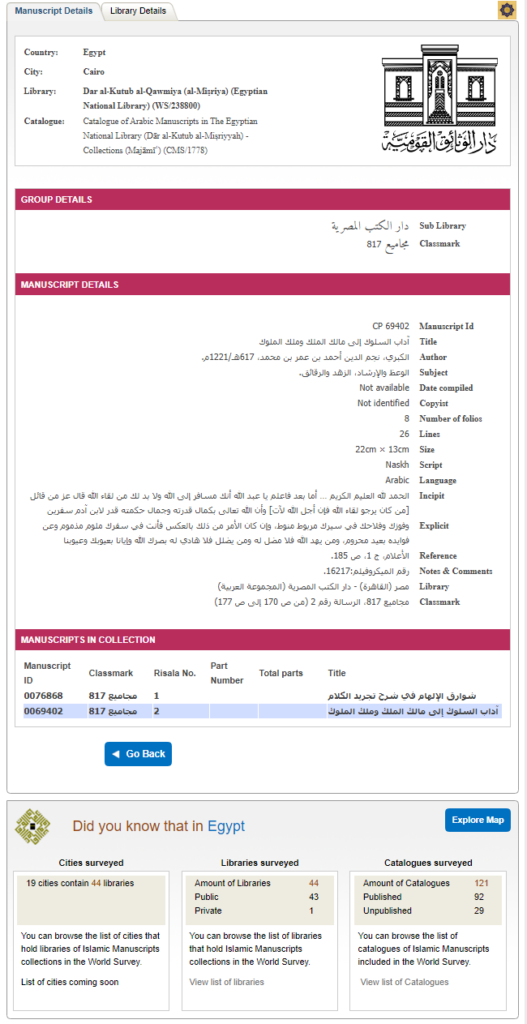
The page also includes a ‘Did you know’ section, where the user can find the full listing of all types of catalogues and their counts regarding the country to which the viewed library belongs. The user is also able to go through the suggested libraries and interchangeably view them on the ‘World Map’ page.
3. ‘Maqasid’ databank / collection
This databank / collection includes the digitised content of the “Bibliography for Maqāṣid al-Sharīʿah”, an encyclopaedic project undertaken and published by Al-Furqān. This comprehensive reference manual and historical documentation of what has been written in the field of Maqāṣid (objectives of Islamic law), identifies and gathers the cumulative research produced over the course of history in this field since the 3rd century of the Islamic calendar, up to date.
The “Bibliography for Maqāṣid al-Sharīʿah” is a unique collection. It includes around 2000 references (manuscripts, university theses, conference proceedings and contemporary studies), in all the madhabs (juridical schools of law) and the Islamic schools of thought.
Users are able to explore this collection by using the following tools:
a) ‘Refine’ tab: the user can filter the search by specifying the ‘Type’ of resources, as well as the ‘Madhab’. The total count of each option in this area is provided between square brackets. These adjust automatically when a new search is carried out.
b) ‘Browse by’ tab: helps the user to filter the search of this collection by ‘Topic’, ‘Names’, ‘Date’ and ‘Madhab’.
c) ‘Results’ page: by default, this page lists all works by titles, arranged alphabetically.

Selecting an item from the ‘Results’ page, brings the item details page, which contains the following sections:
a) ‘Item’ page: this page provides details of the particular item/s selected. The title of the page adjusts automatically; based on the type of the item / resource that is inspected (Books, Thesis, or Articles).
b) ‘Summary’ page: the user is provided with an extensive summary (1000 words on average), detailing the content of the publication and its importance.
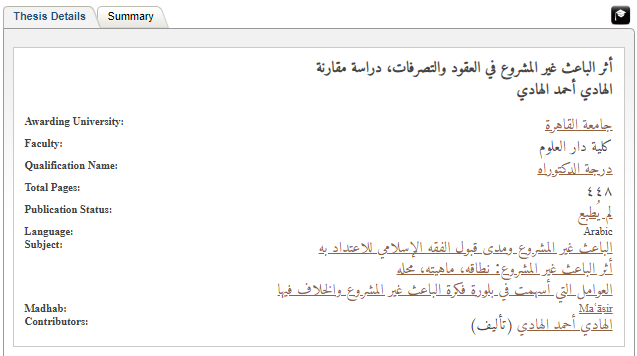
4. ‘Our Library’ databank / collection
Our E-Database also includes the online catalogue of the holdings of the Al-Furqān’s physical Library. It is an electronic bibliographic database which describes the Library items, and the way of accessing them.
The Library Collection represents a cornerstone reference collection on major research areas, including Islamic manuscripts. The major subjects covered are: Qur’anic studies, Hadith, Islamic jurisprudence, Islamic theology, philosophy, science, medicine, history, geography, art and architecture, and literature; all of them written in the major Islamic languages, including Arabic, Persian, Turkish, Urdu, Swahili, Gujarati, as well as European languages and Russian. The Library collection also includes multilingual dictionaries, Arabic biographical dictionaries and encyclopaedias, covering the classical period to the present time.
To date, the Library has collected over 11,000 titles in more than 16,000 volumes, on various subjects. Moreover, the Library's collections include almost 1,800 printed Islamic manuscript catalogues in around 2,500 volumes, from over 70 countries.
The library’s holdings are arranged and organised according to the Library of Congress Classification (LCC) for ease of use, while its collection of catalogues of Islamic manuscripts is classified by country.
Users are able to explore this collection by using the following tools:
a) ‘Refine’ tab: the user can filter his search through this bibliographic databank by setting limitations to references ‘Featured’ in the ‘World Collections‘ databank, by ‘Type’ of resources and types of ‘Catalogues’, by ‘Language’, and by ‘Country’.
b) ‘Browse by’ tab: helps the user explore the Library holdings by ‘Names’ of contributors and authors, ‘Subject’ of the collection, the ‘Library Catalogues’, and ‘Country’. This feature is very popular among our users, especially when they aim to travel from different countries in order to consult Our Library collections.
c) ‘Results’ page: by default, this page lists all items by ‘Title’, in alphabetic order.
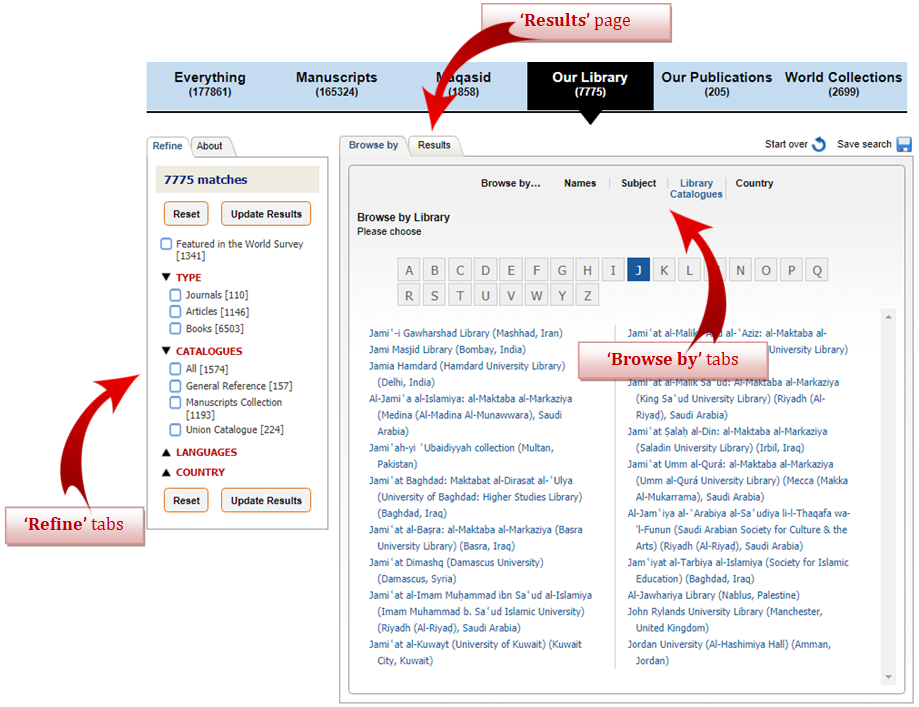
The user can review more information about a reference by either selecting an item from the ‘Results’ page listing, or from the ‘Browse by’ page. Details about the item and how to access are provided in the following display:
a) ‘Item’ page: this page provides details of the particular item/s selected from the Library holdings. The title of the page adjusts automatically; based on the type of the item / resource that is inspected (Books, Journals or Articles).
b) ‘MARC’ page: this page is a more technical representation of the Library holdings record, knows as a ‘MARC’ record, which is a Machine-Readable Cataloguing record. It is an international standard used to communicate and exchange information between databases online. The aim for this is to enable communication with other online databases, to help users know about the collection held in the respective library.
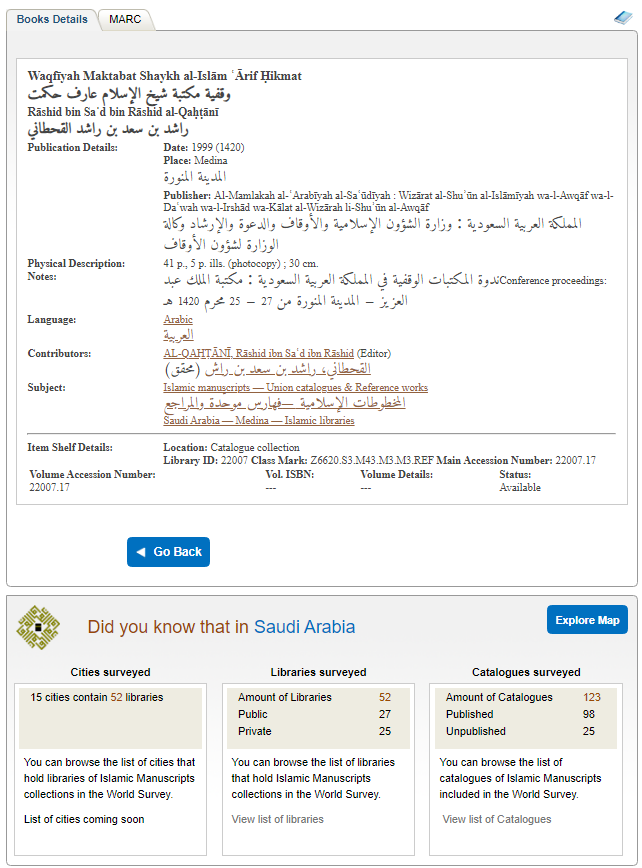
When the items browsed are part of the Library’s ’Catalogue Collection’, the page interlinks with the ‘World Collections’ databank. The two new sections provided help pave the way for further research; the first is the ‘Library Description’page, where details about the Library of certain collection are provided, and the second is the ‘Did you know’ section, where the users can view the full listing of all types of catalogues and their counts in one place, for the country where the explored library is located.
5. ‘Our Publications’ databank / collection
‘Our Publications’ collection is a bibliographic database of the Foundation's own publications. These works are the outcome of prominent research projects and events carried out by the three centres of the Foundation, i.e. the ‘Manuscripts Centre’, the ‘Mawsoa Centre’ and the ‘Maqasid Centre’.
This collection was added to the E-Database to enrich the user research experience. The collection is continuously updated, and currently contains over 200 works in over 400 volumes. These cover both introductory and advanced topics discussed and presented by distinguished scholars in the field of Islamic written heritage.
It also includes many popular and heavily cited publications, as well as award winning works, such as the critical edition of al-Isfizāri’s book which deals with the field of mechanics, known as “the sciences of weights and mechanical devices” (‘Ilmay al-Athqāl wal-Ḥiyal). Other popular items include works by the late famous scholar Annemarie Schimmel, such as The Secrets of Creative Love (1998) and Islam and the Wonders of Creation (2003); and many other highly demanded references, including the unique Encyclopaedia of Makkah Al-Mukarramah and Al-Madīnah Al-Munawwarah.
Users are able to explore the range of publications by using the following tools:
a) ‘All Publications’ tab: which helps the user browse different books within the following categories: ‘Conferences’, ‘Course Proceedings’, ‘Edited Texts’, ‘Studies’, ‘Lectures’ and many others listed under the three centres. The count for each type and within each category is also available.
b) ‘Refine’ tab: helps the user to filter through this collection, by specifying the ‘Centre’ and the ‘Category’. The total count within each of these remits is provided. This count adjusts automatically with each search and browse action.
c) ‘Results’ page: at the start of the page, the user is provided with the option to browse all publications. The browse facility also allows the user to browse by ‘Topic’, ‘Name’ and ‘Date’ of publication. This is followed by the full listing of the titles alphabetically. The listing also includes the ‘Title’ of the publication, the ‘Name’ of the author / contributor, the ‘Date’ of compilation, and the ‘Price’ of the publication.
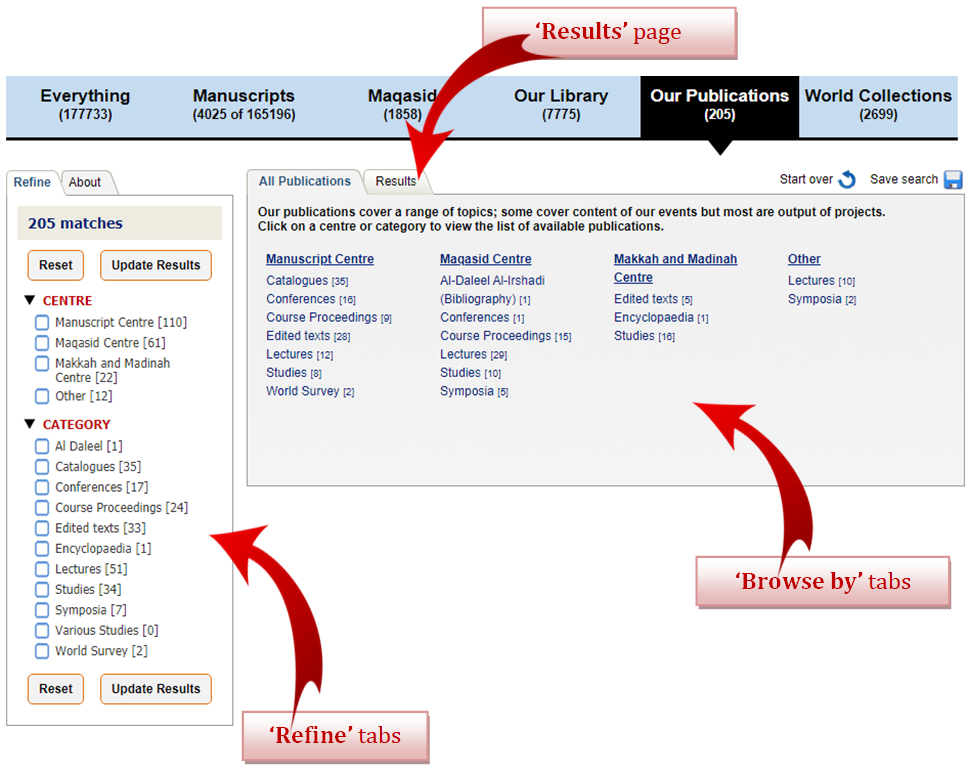
Once a selection of a publication is made, the user is transferred to a landing page, where detailed information about that particular publication is provided. This includes the cover of the publication, the related bibliographical details, and a summary about that publication.
It is possible to view ‘Similar books’ by the same author, within the same topic, and in the same language from within the bibliographical details area.
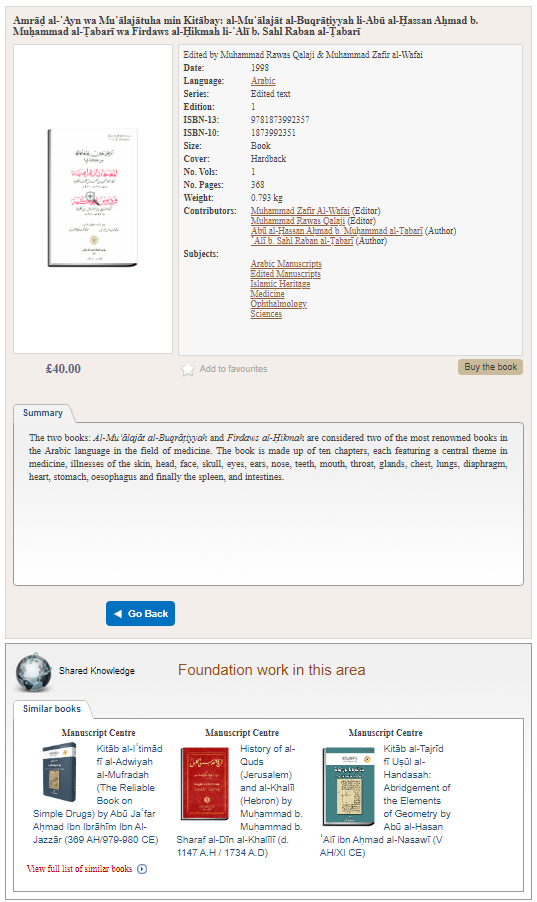
When the publication selected is a catalogue of Islamic manuscripts, there is an additional page that displays the ‘Library Description’. This page is interlinked with the ‘World Collections’, and provides information about the library that holds that collection.
The page also includes a ‘Shared Knowledge’section, in which the user can be informed about the ‘Foundation’s work in this area’. This helps the user with narrowing their research further, and guides them towards more relevant available resources. A sample of these works is displayed in the ‘Similar books’ page within this section.
The ‘Shared Knowledge’ is available in every publication details page, except for when the publication is a catalogue of Islamic manuscripts. In this case, this section is replaced with the ‘Did you know’ section. The user can interchangeably return to the ‘World Collections’ for the full listing of all types of catalogues available in the surveyed country where the collection is held.

